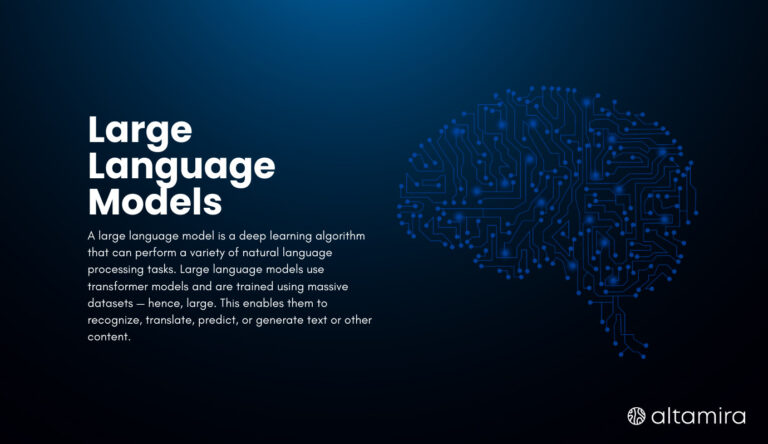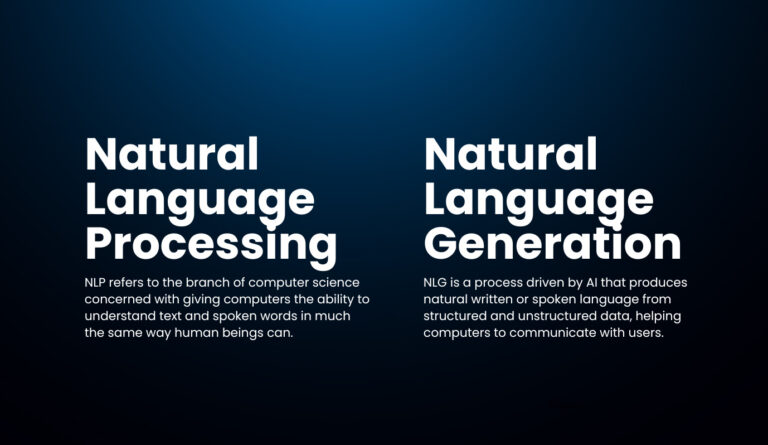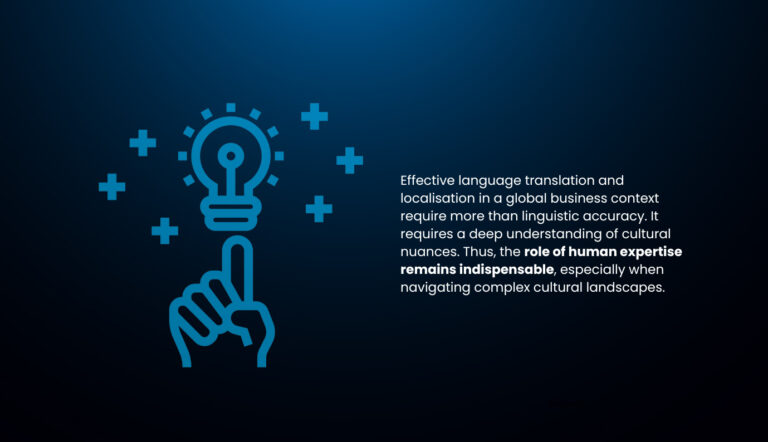Table of Contents
Artificial intelligence is currently a hot topic on everyone’s mind, from Silicon Valley to Silicon Savannah. The latest AI sensation is being driven by large language models (LLMs).
Moreover, small and medium-sized enterprises (SMEs) have ample chances to enhance their efficiency with these models, revealing new horizons in innovation. You may wonder, what are large language models? Let’s look in more detail!
LLM – definition and more
Large language models represent long-term and gradual advancement in the way we engage with computers. Our journey has evolved from using basic programming languages to the user-friendly graphical user interfaces, like Microsoft Windows, macOS, or Ubuntu Unity, that are part of our daily lives.

Large language models explained as an AI algorithm that uses deep learning and extensive datasets to understand, summarise, create, and forecast new content from an open-source base.
Often referred to as generative AI, LLMs are mainly used for text-based applications and can be developed and implemented using platforms like Hugging Face and various LLM APIs.
All language models are trained using machine-learning datasets. They employ diverse methodologies to deduce relationships and then generate new content based on this trained data, often resulting in a format suitable for question-answering.
LLMs, like the Generative Pre-Trained Transformer (GPT) models, incorporate both Natural Language Processing and Natural Language Generation capabilities, facilitating various tasks like text generation and translation, just to name a few.

OpenAI introduced the first LLM with its GPT series, thus revolutionising natural language processing with its capability to produce text closely resembling human speech.
This breakthrough set the stage for subsequent versions, like GPT-2 and GPT-3, which further improved the ability of AI systems to understand and generate content, marking significant advancements in the field.
LLMs in SMEs: How do businesses use these models?
A number of AI large language models and applications powered by these models have achieved considerable success across numerous domains, including but not limited to:
- Automation: SMEs take advantage of LLMs to automate routine tasks and processes, thus saving significant time and resources. By inputting clear instructions and examples, LLMs can be trained and adapted to execute a range of tasks, minimising the necessity for manual input.
- Customer service: LLMs play an integral role in improving customer interactions. SMEs can create AI-powered chatbots or virtual assistants by training LLM models with specific customer data and queries. These advanced systems can even deliver personalised and efficient customer service, which can significantly boost customer satisfaction and retention.
- Language translation and localisation: LLM models are able to provide precise and nuanced translations for marketing materials, product descriptions, and customer interactions. This capability facilitates effective communication with international markets, thereby broadening the scope for business expansion and opportunities.
However, effective language translation and localisation in a global business context require more than linguistic accuracy.
It requires a deep understanding of cultural nuances. Thus, the role of human expertise remains indispensable, especially when navigating complex cultural landscapes.

- Content creation: By feeding LLMs with examples and guidelines, businesses can automate the generation of various content pieces, including blog articles, social media updates, and product descriptions, helping to maintain consistent messaging across different platforms.
- Data Analysis: These models are adept at processing large volumes of textual data, detecting patterns, and producing insightful reports. This capability facilitates decision-making and offers SMEs a competitive advantage in their respective markets.
What are the benefits of LLMs for business?
Here are some ways in which employing an LLM can support and streamline your business operations:
- Versatility: LLMs offer a wide range of benefits through capabilities like multi-language text generation, automated translation, efficient text summarisation, content rewriting, data classification, sentiment analysis, and natural conversational AI experiences. Consequently, SMEs can significantly enhance efficiency and overall business performance by using these diverse functionalities.
- Flexibility: SMEs can deploy LLMs for numerous tasks, optimising resource allocation and fully tapping into their potential. With the ability to adapt to diverse scenarios, LLMs empower businesses to streamline processes and garner insights.
- Accuracy: SMEs can significantly boost the quality of their materials, the analyses focus, and the reliability of their information by utilising precise LLM models. The precision of LLMs enables SMEs to consistently deliver high-quality content.
- Training: LLMs facilitate a more streamlined training process by using unlabelled data, eliminating the need for time-consuming manual annotation. It saves time and resources for businesses, enabling them to deploy LLM-powered applications more swiftly. With LLMs, SMEs can train models on diverse datasets, capturing complex language patterns and nuances, further improving these models’ applicability in various business contexts.
What are the major challenges for SMEs in LLM adoption?
While LLMs models secure numerous benefits, there are also some challenges and restrictions.
Challenge 1: Development and operational costs
The deployment of LLMs often involves significant investment in high-powered graphics processing units and extensive data, leading to potentially high operational costs for the host organisation. However, emerging trends and innovative approaches are making these powerful tools more accessible and feasible for smaller businesses.
1. Cloud-Based LLM Services
Many leading tech companies are now offering LLMs as cloud-based services. This model allows SMEs to access state-of-the-art language models without substantial upfront investment in hardware and software infrastructure.
This reduces the entry barrier for smaller businesses, enabling them to pay only for the computational resources they use.
2. Pre-Trained Models
The availability of pre-trained models that can be further fine-tuned for specific tasks significantly lowers the cost and complexity of using LLMs.
SMEs can leverage these models for a range of applications without the need for extensive LLM machine-learning expertise or resources to train models from scratch.
3. AI as a Service (AIaaS)
AIaaS providers are making it easier for businesses to integrate AI into their operations by offering AI technologies, including LLMs, as part of a service package.
This allows SMEs to adopt AI solutions with minimal risk and lower cost, providing flexibility and scalability as business needs evolve.
Challenge 2: Bias
LLMs may unintentionally echo biases from their training datasets. It’s vital for businesses to recognize these ethical issues and actively reduce bias. SMEs can adopt strategies like using diverse and inclusive training data, monitoring outputs for bias, and working with diverse teams to minimise biases and promote fair representation.
Challenge 3: Hallucination
Regarding large language models, AI hallucination occurs when an LLM produces incorrect responses not based on learned data. These models try to create convincing content, yet they cannot verify the accuracy.
This issue can be addressed with filtering techniques, fine-tuning the model with domain-specific data, using external knowledge sources, and incorporating human oversight.
Challenge 4: Glitch tokens
Glitch tokens are intentionally crafted prompts that disrupt the functioning of LLMs, leading to compromised reliability and usability. These tokens can result in the model generating unintended or nonsensical outputs.
In this case, the implementation of robust error handling, fine-tuning the model with domain-specific data, enhancing post-processing, and identifying and filtering out such glitch tokens can improve the model’s performance.
How do you navigate technical and ethical challenges?
Regardless of the size of your enterprise, integrating LLMs can provide a significant edge in today’s competitive market. So, what’s stopping you from using large language models (LLM)?
- Data Privacy and Security: Businesses frequently manage sensitive client information, making data privacy a critical concern.
In the context of using products powered by LLMs, it’s important to establish strong data encryption and access control measures. Companies should also adhere to data protection laws and consistently oversee their data management practices. - Specialised Knowledge: While LLMs are adaptable, companies may lack in-depth expertise in specific fields. For businesses using large language models in healthcare or finance, it’s advisable to augment with domain-specific knowledge. Alternatively, training LLMs on data tailored to their industry can improve their effectiveness in these niche areas.
- Implementation limitations: Adopting products driven by large language models into existing operational frameworks and systems can be challenging.
Start with ensuring that these products are compatible with current technological infrastructures, offering comprehensive training to staff, and addressing potential scalability issues. - Cost-benefit evaluation: LLMs incorporation can potentially reduce costs, but it’s critically important for enterprises to perform a detailed cost-benefit analysis.
This involves calculating the return on investment and estimating the continuous operational expenses associated with LLM integration.
Bottom line
Integrating AI into a business might sound challenging, but with the current user-friendly tools and platforms, even entrepreneurs without a technical background can take advantage of LLMs.
Top large language models offer a transformative opportunity for businesses in diverse sectors, including marketing, healthcare, and eCommerce.
Efficient resource management is key for small and medium-sized businesses. LLMs can streamline tasks like project management and scheduling, automating these processes to free up time for strategic decision-making and creative endeavours.
Altamira is a reliable tech partner specializing in helping organizations scale faster and more sustainably.
We offer a range of AI development services to clients across various industries, helping to adopt best practices and integrate AI/ML solutions smoothly. Contact us to discover how we can enable AI-powered digital transformation at your company.



